Explore Chiang Rai - Thailand Travel, Asia
Welcome to Chiang Rai, a captivating destination in Northern Thailand that promises a blend of history, culture, and stunning natural beauty. Known for its unique temples, lush landscapes, and vibrant local culture, Chiang Rai offers travelers an immersive experience away from the bustling tourist crowds of Bangkok. Its strategic location near the borders of Laos and Myanmar adds a touch of international allure as this city serves as a cultural and historical hub, reflecting the rich heritage of the Lanna Kingdom and offering a glimpse into traditional Thai life. Dive into Chiang Rai’s diverse attractions, and discover why it’s a must-visit destination for anyone exploring Northern Thailand.
Population: Approximately 70,000 in 2012.
Economy: Chiang Rai's economy thrives on agriculture, tourism, and trade. Known for tea, coffee, and fruit production, it also attracts visitors to its cultural landmarks and natural beauty, boosting local businesses.
Landmarks: Famous for the Wat Rong Khun (or the White Temple), Wat Phra Kaew, and Baan Dam Museum.
Thailand
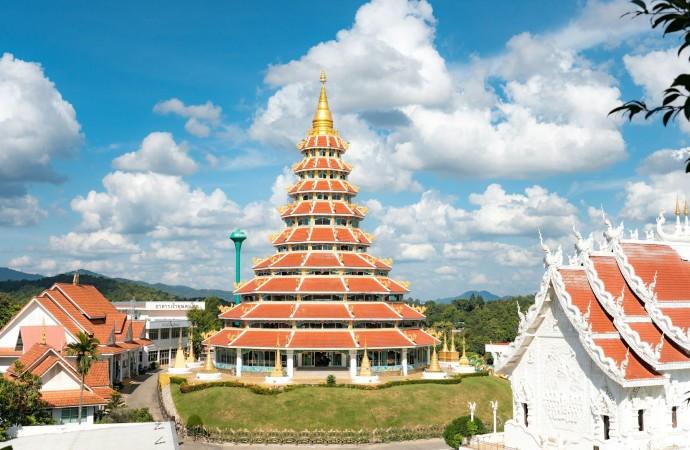
Overview of Chiang Rai
History & Cultural Influence
Chiang Rai's history is deeply intertwined with the legacy of the Lanna Kingdom, a powerful state that once ruled over Northern Thailand. This rich historical backdrop is evident in the city's numerous ancient temples and cultural landmarks. One of the most iconic sites is the Wat Rong Khun, also known as the White Temple, a stunning example of modern Buddhist architecture, combining traditional elements with a unique artistic vision. Its sparkling white facade symbolizes purity, and its intricate decorations tell profound spiritual stories. The city's historical and cultural attractions provide a glimpse into its history, highlighting the exquisite craftsmanship and spiritual traditions that have helped form its character.
Interaction with The Locals
The city's diverse demographic includes Thai locals as well as ethnic minorities such as the Akha, Lisu, and Karen. Chiang Rai residents are well-known for their friendliness and warmth, which adds to the city's pleasant vibe. This blend of cultures and traditions enriches Chiang Rai's vibrant community, making it a unique destination for travelers seeking an authentic Thai experience.
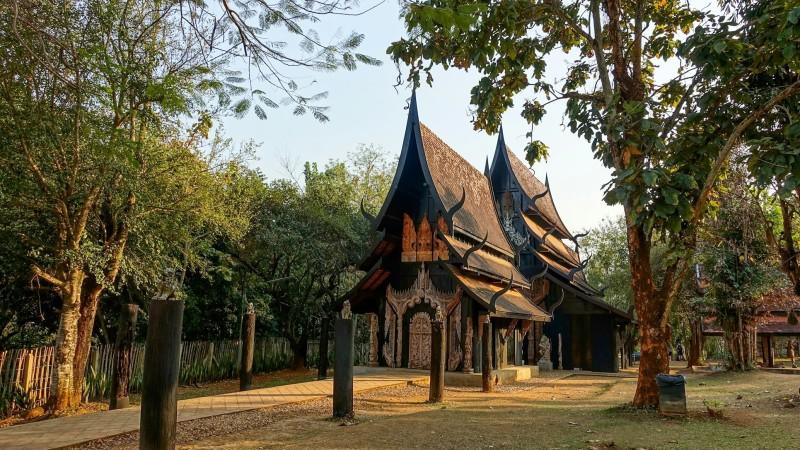
Baan Dam Museum (Black House) - © Peter Border
Top Attractions in Chiang Rai
Chiang Rai boasts an array of attractions that highlight its cultural and natural beauty. Each of these attractions offers a unique glimpse into Chiang Rai’s diverse heritage and natural splendor, making them essential stops on your journey through this enchanting city.
- Wat Rong Khun (White Temple): This surreal, all-white temple is a masterpiece of modern Buddhist art. Its intricate designs and reflective surfaces create a striking contrast against the surrounding landscape. Designed by Chalermchai Kositpipat, the temple blends traditional Thai elements with contemporary artistic interpretations, making it a must-visit for art and architecture enthusiasts.
- Wat Phra Kaew: Known for its historical significance, this temple was once home to the Emerald Buddha, Thailand’s most revered Buddhist artifact. Although the Emerald Buddha is now housed in Bangkok, Wat Phra Kaew remains an important historical and cultural site, showcasing ancient Lanna architecture and artistry.
- Golden Triangle: Located at the confluence of the Mekong and Ruak rivers, the Golden Triangle is a region rich in history and natural beauty. This area marks the meeting point of Thailand, Laos, and Myanmar, and offers stunning river views and insights into the region’s historical opium trade.
- Baan Dam Museum (Black House): Created by artist Thawan Duchanee, this museum is a collection of dark, eclectic buildings showcasing art and artifacts that reflect the artist’s unique vision and cultural heritage. It contrasts starkly with the White Temple, offering a different perspective on Thai artistic expression.
- Doi Tung Royal Villa: Set amidst lush gardens and mountainous landscapes, this royal villa was once the residence of the late Princess Mother, Srinagarindra. The villa and its gardens are a testament to her efforts in promoting sustainable development and agricultural improvement in the region.
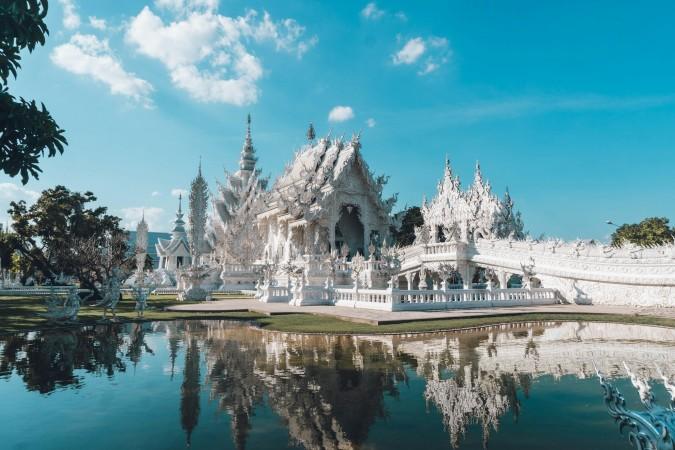
Wat Rong Khun (White Temple) - © Aleksandra B.
Must-Try Dishes in Chiang Rai
Chiang Rai's culinary tradition is a feast for the senses, showcasing a variety of dishes that reflect the region's rich cultural heritage.
- Khao Soi: This Northern Thai specialty is a creamy curry noodle soup with a delightful mix of crispy and soft egg noodles. The rich, aromatic broth is made from a blend of spices and is typically topped with pickled mustard greens, shallots, and lime. It’s a flavorful and comforting dish that captures the essence of Northern Thai cuisine.
- Sai Oua: A traditional herb-infused sausage, Sai Oua is made with minced pork mixed with garlic, lemongrass, and a variety of spices. Grilled to perfection, this savory sausage is often enjoyed with sticky rice and fresh vegetables, offering a burst of flavors.
- Nam Prik Ong: This tangy chili dip combines minced pork, tomatoes, and chili peppers, creating a rich and spicy flavor. Served with fresh vegetables and sticky rice, Nam Prik Ong is a beloved dish in Northern Thailand and a great way to experience local tastes.
- Sticky Rice with Mango: A popular Thai dessert, this dish pairs sweet, fragrant mango with sticky rice cooked in coconut milk. The end product is a delicious blend of sweetness and creaminess, making it a welcome finish to any meal.
- Khao Niew Mamuang: Another variation of sticky rice, this dessert features sweet coconut-flavored rice paired with ripe mango slices. Often enjoyed during mango season, it’s a simple yet satisfying treat.
- Gaeng Hang Lay: Gaeng Hang Lay is a thick, spicy Northern Thai curry with Burmese influences that features pork belly, ginger, and tamarind. The curry is known for its deep, complex flavors and is often served with rice.
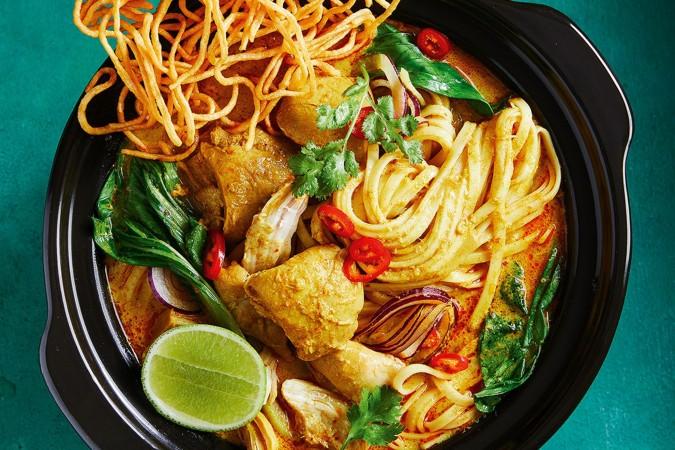
Khao Soi - © Taste
Festivals & Local Celebrations
Chiang Rai is a city brimming with vibrant festivals and local celebrations that highlight its rich cultural heritage and community spirit. These events provide a unique glimpse into the traditions and customs of Northern Thailand.
Songkran Festival (Thai New Year)
Held every April, Songkran marks the Thai New Year with a grand celebration that involves splashing water. Originating as a traditional way to wash away the old year and welcome the new, Songkran in Chiang Rai transforms into a lively water festival. Streets are filled with revelers armed with water guns and buckets, creating an exhilarating and festive atmosphere. The celebration also includes religious ceremonies, such as pouring water over Buddha statues and visiting temples to seek blessings.
Chiang Rai Flower Festival
The Chiang Rai Flower Festival, held in January, is a visual feast for nature enthusiasts. This annual event showcases the region’s floral diversity, with vibrant displays of blooming flowers, intricate garden designs, and landscape art. The festival features flower parades, garden exhibitions, and cultural performances, making it a perfect opportunity to experience Chiang Rai’s natural beauty and artistic flair. Visitors can stroll through beautifully arranged floral displays and enjoy a variety of local food and crafts.
Loy Krathong Festival
Loy Krathong, which takes place in November, is one of Thailand's most magical celebrations. The festival involves floating decorated baskets, or “krathongs,” onto rivers and lakes. These krathongs, often made of banana leaves and adorned with flowers, candles, and incense, symbolize letting go of past grievances and making wishes for the future. In Chiang Rai, the festival is marked by beautiful river ceremonies and lantern releases, creating a magical atmosphere with thousands of glowing lights reflecting on the water.
Boon Bang Fai Festival
Known as the Rocket Festival, Boon Bang Fai is celebrated in the rural areas around Chiang Rai in May. This unique festival involves launching homemade rockets into the sky as a way to encourage rainfall for the upcoming rice planting season. The festival is marked by colorful parades, traditional music and dance performances, and communal feasting. It’s a lively event that reflects the agricultural traditions and community spirit of the region.
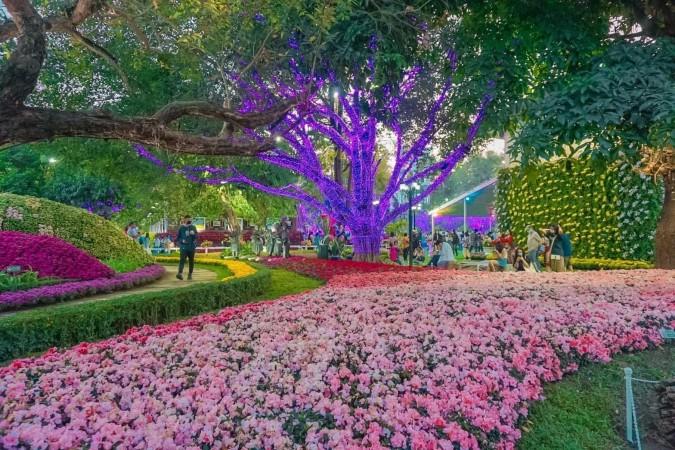
Chiang Rai Flower Festival - © Richard Barrow
What to Do in Chiang Rai
Chiang Rai offers a range of activities that cater to diverse interests, ensuring a memorable visit.
- Jungle Trekking in Chiang Rai: Explore the lush landscapes surrounding Chiang Rai through guided jungle treks and nature tours. These excursions offer opportunities to observe diverse wildlife, scenic waterfalls, and traditional hill tribe villages.
- Mekong River Cruises: Take a relaxing river ride down the Mekong River, which forms the boundary between Thailand, Laos, and Myanmar. The voyage provides stunning views of the countryside as well as opportunities to learn about the region's history and culture.
- Local Market Exploration: Immerse yourself in Chiang Rai’s local culture by visiting bustling markets like the Night Bazaar. Browse through handmade crafts, local produce, and delicious street food while interacting with friendly vendors.
Shopping in Chiang Rai
Chiang Rai offers an excellent shopping experience with a diverse range of marketplaces and boutiques.
- Chiang Rai Night Bazaar: This bustling market is a hub for souvenirs, local handicrafts, and street food. It’s a great place to pick up unique gifts, such as handcrafted jewelry, traditional textiles, and artisanal goods. The vibrant ambiance and numerous offers make it a must-see for shoppers.
- Central Plaza Chiang Rai: Central Plaza offers a contemporary shopping experience with a wide range of retail stores, dining options, and entertainment amenities. It’s an ideal spot for those seeking both international brands and local products in a comfortable setting.
- Local Handicraft Markets: Explore smaller markets around Chiang Rai for authentic, handcrafted items. These marketplaces frequently sell traditional Thai products, such as elaborate wood carvings, vivid fabrics, and stunning ceramics. They provide a chance to support local artisans and find one-of-a-kind treasures.
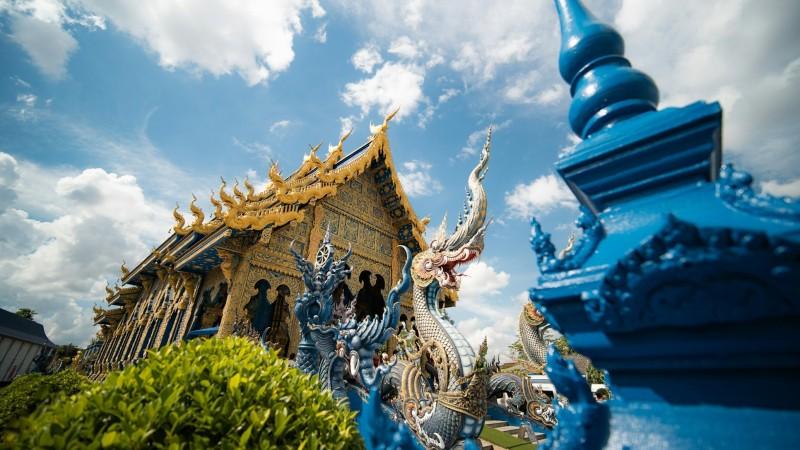
Explore Wat Rong Suea Ten (Blue Temple) - © CJ Botha
Weather in Chiang Rai: Best Time to Visit
Chiang Rai experiences a tropical climate with distinct wet and dry seasons, making it a year-round destination with varying weather patterns. Understanding the weather might help you organize your vacation to this northern beauty more successfully.
Cool Season in Chiang Rai
This is the most popular time to visit Chiang Rai, thanks to the pleasant and cool weather. Temperatures range from 15°C to 30°C (59°F to 86°F), providing comfortable conditions for sightseeing and outdoor activities. The skies are usually clear, and humidity levels are lower, making it ideal for exploring the city and its surroundings.
Hot Season in Chiang Rai
During these months, Chiang Rai has greater temperatures, which can reach 35°C (95°F). The heat can be intense, particularly in April and May, making it important to stay hydrated and use sun protection. Despite the heat, this period is less crowded, and you might find some great deals on accommodations and flights.
Rainy Season in Chiang Rai
The rainy season brings frequent showers and thunderstorms, with heavy rainfall often occurring in the afternoons and evenings. Temperatures during this period are typically between 24°C and 33°C (75°F to 91°F). While rain might hamper travel plans, it also refreshes the scenery and adds to the region's lush flora. If you don’t mind occasional downpours, this can be a good time to enjoy fewer tourists and lower prices.
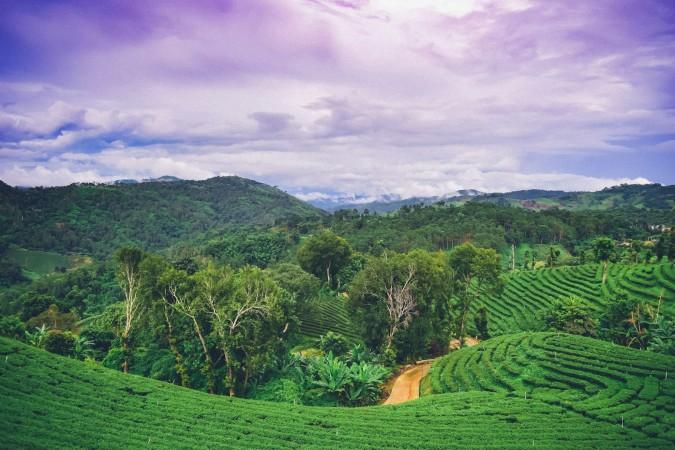
A clear day to trek in Chiang Rai - © Nopparuj Lamaikul
Essential Travel Information
Getting Around Chiang Rai
- Tuk-Tuks: These three-wheeled vehicles are a popular and fun way to explore Chiang Rai. Tuk-tuks are ideal for short distances and provide a unique local experience.
- Songthaews: These shared red trucks operate as a form of public transportation and are an affordable way to travel around the city. They follow specific routes, and passengers can hop on and off as needed. It’s a practical option for both tourists and locals.
- Bicycles and Motorbikes: Renting a bicycle or motorbike is a great way to explore Chiang Rai at your own pace. Many rental shops offer affordable rates.
- Taxis and Ride-Sharing: Taxis are available in Chiang Rai, though they may be less common than tuk-tuks and songthaews. Ride-sharing apps like Grab are also operational, offering a convenient way to book rides with fixed fares.
- Car Rentals: Renting a car provides additional freedom. This allows you to discover Chiang Rai and its surroundings at your own speed. Make sure you have an international driving permit and are familiar with the local driving rules.
ATM & Banking Services
Chiang Rai offers convenient access to banking services and ATMs throughout the city. ATMs are widely available and allow for cash withdrawals using international credit and debit cards, though transaction fees may apply. For currency exchange and additional banking needs, several branches are scattered across the city, where you’ll need to present identification, such as your passport. Currency exchange services can also be found at dedicated booths and some hotels, though rates may vary. While credit cards are accepted in many hotels, restaurants, and shops, carrying some cash is advisable for smaller establishments and local markets where card payments might not be accepted.
Where to Stay in Chiang Rai
- Luxury Hotels: For a touch of luxury, Chiang Rai boasts several high-end hotels with top-notch amenities, including Chiang Rai, which offers elegant rooms, swimming pools, and fine dining. These establishments provide a comfortable and upscale experience for travelers seeking luxury.
- Boutique Hotels: Experience a blend of charm and comfort with boutique hotels. These smaller, stylish hotels often feature unique decor and personalized service. They offer a cozy atmosphere and are typically located in central areas, making it easy to explore local attractions.
- Guesthouses and Hostels: Budget travelers will find a variety of guesthouses and hostels in Chiang Rai. These accommodations offer affordable rates and a chance to meet fellow travelers. Many guesthouses provide simple yet comfortable rooms and common areas for socializing.
- Resorts: For a tranquil escape, consider staying at one of Chiang Rai’s resorts. These properties are often located in scenic areas and offer amenities such as spas, swimming pools, and outdoor activities. Resorts provide a relaxing retreat away from the city’s hustle and bustle.
- Homestays: For a more authentic experience, homestays offer a chance to stay with local families. This choice offers a distinct perspective on Thai culture and everyday life. Homestays often include meals and personalized experiences, enhancing your cultural immersion.
Articles for you

Explore Yala National Park - Sri Lanka Travel, Asia
Tucked away in Sri Lanka’s southeastern corner, Yala National Park is where wild nature meets deep tradition. Known worldwide for its leopard population, the park is also home to elephants, sloth bears, crocodiles, and hundreds of bird species. Beyond wildlife, Yala opens doors to a cultural landscape dotted with ancient temples, Buddhist ruins, and coastal villages. For travelers seeking more than just a safari, Yala offers a chance to explore eco-tourism, local communities, and sacred heritage sites.
Population: The Yala National Park area doesn’t have a human population.
Economy: The economy around Yala National Park thrives on a blend of eco-tourism, agriculture, and local services. Safari tours, eco-lodges, and cultural experiences drive steady income for nearby towns like Tissamaharama and Kataragama, supporting thousands of families.
Landmarks: Famous for Block I of Yala and wildlife encounters, including elephants, sloth bears, crocodiles, and exotic bird species.

Explore Galle - Sri Lanka Travel, Asia
Nestled on Sri Lanka’s southern coastline, Galle is a vibrant city where history meets the sea. Its cobbled streets, colonial architecture, and serene beaches make it a must-visit destination for travelers seeking a blend of culture, adventure, and relaxation. A UNESCO World Heritage site, Galle captivates visitors with its Dutch Fort, bustling markets, and friendly locals. Whether you’re exploring the ramparts at sunset or savoring fresh seafood by the shore, Galle promises an unforgettable journey into Sri Lanka’s heritage.
Population: Approximately 113,000 in 2023.
Economy: Galle’s economy thrives on tourism, trade, and fisheries. The city’s historic fort, colonial architecture, and coastal charm draw thousands of international visitors each year, making tourism its main economic driver. Fishing remains vital for local livelihoods, supplying fresh seafood across the region.
Landmarks: Famous for the Galle Fort, Dutch Reformed Church & Maritime Museum, and Unawatuna Beach.

Explore Bentota - Sri Lanka Travel, Asia
Nestled along Sri Lanka’s southwestern coast, Bentota is a tropical paradise that blends golden beaches, vibrant culture, and thrilling adventures. Famous for its calm waters, luxury resorts, and scenic river estuary, Bentota has become a top destination for travelers seeking both relaxation and authentic experiences. From serene beach walks at sunrise to adrenaline-pumping water sports, this coastal town offers a perfect balance of leisure and exploration. With its proximity to Colombo and Galle, Bentota is easy to reach, making it an ideal stop for both short escapes and extended holidays.
Population: Approximately 37,000 in 2023.
Economy: Bentota’s economy thrives mainly on tourism, which drives local businesses such as hotels, restaurants, and wellness retreats. The town also benefits from fishing, coconut cultivation, and handicrafts like wood carving and batik textiles. Many residents rely on the growing demand for water sports and Ayurvedic treatments, making tourism the backbone of both income and employment in the area.
Landmarks: Famous for Bentota Beach, Bentota River Safari, and Kande Vihara Temple.

Explore Mirissa - Sri Lanka Travel, Asia
Mirissa is a charming coastal town on Sri Lanka’s southern shoreline. Known for its golden beaches, turquoise waters, and vibrant marine life, it has become a must-visit stop for travelers exploring the island. Many come for whale watching, surfing, and sunset views at Coconut Tree Hill, but Mirissa offers much more than postcard beauty. The fishing boats you see anchored by the bay carry generations of stories. Local traditions, delicious cuisine, and a laid-back rhythm of life shape every visitor’s experience.
Population: Approximately 4,700 in 2023.
Economy: Mirissa’s economy is largely shaped by its coastal location. Fishing has long been the backbone of local livelihoods, with generations relying on the Indian Ocean for income. In recent decades, tourism has become the main driver of growth, thanks to whale watching, surfing, and beachside hospitality.
Landmarks: Famous for Mirissa Beach, Coconut Tree Hill, and Parrot Rock Bridge.

Explore Nuwara Eliya - Sri Lanka Travel, Asia
Tucked away in the Central Highlands of Sri Lanka, Nuwara Eliya is often called “Little England”. With its rolling tea plantations, cool misty mornings, and colonial charm, this mountain town feels like a step into another world. Travelers come here to breathe fresh air, walk through flower gardens, sip the finest Ceylon Tea, and enjoy a pace of life far from the island’s busy cities. Whether you’re drawn by scenic landscapes, heritage architecture, or the warmth of its people, Nuwara Eliya is a destination that blends nature, culture, and history in perfect harmony.
Population: Approximately 781,000 in 2023.
Economy: Nuwara Eliya’s economy thrives mainly on tea production, as it sits in the heart of Sri Lanka’s central highlands, famous worldwide for Ceylon Tea. The city also benefits from a growing tourism industry, attracting visitors with its colonial charm, cool climate, and scenic landscapes.
Landmarks: Famous for Gregory Lake, Hakgala Botanical Garden, and Victoria Park.

Explore Sukau - Malaysia Travel, Asia
Nestled on the banks of the Kinabatangan River in Sabah, Malaysian Borneo, Sukau is a destination where wildlife, culture, and conservation come together. Known as one of Asia’s top spots for river safaris and eco-tourism, this quiet village offers a front-row seat to encounters with Bornean orangutans, pygmy elephants, proboscis monkeys, and exotic birdlife.
Population: Approximately 1,400 in 2019.
Economy: Sukau’s economy is shaped by its riverine location and natural resources. Traditionally, the Orang Sungai community relied on fishing, small-scale farming, and forest gathering for their livelihood. Today, the village has shifted toward eco-tourism, with river cruises, jungle trekking, and homestays providing income.
Landmarks: Famous for the Kinabatangan River cruises, Gomantong Caves, and Ox-bow lakes and wetlands.
